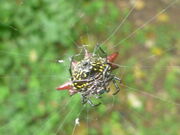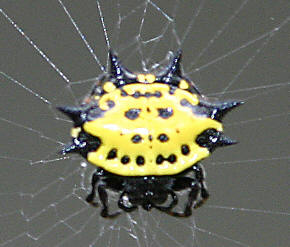
Gasteracantha cancriformi (the star spider, spiny-backed orbweaver, spiny orbweaver spider, crab-like orbweaver spider, crab-like spiny orbweaver spider, jewel spider, spiny-bellied orbweaver, jewel box spider or smiley face spider) is a species of spider.
Females are 5–9 millimetres (0.20–0.35 in) long and 10–13 mm (0.39–0.51 in) wide. The six abdominal spine-like projections on the abdomen are characteristic. The carapace, legs and underside are black with white spots under the abdomen. Variations occur in the colour of the upperside of the abdomen: a white or yellow colour with both featuring black spots. A white upperside can have either red or black spines while a yellow upperside can only have black ones. Like in many other spiders, males are much smaller (2 to 3 mm long) and longer than wide. They are similar to the females in colour but have a gray abdomen with white spots and the spines are reduced to four or five stubby projections.
It is found across the southern part of the United States from California to Florida, as well as in Central America, Jamaica, Cuba, Dominican Republic, Bermuda, South America and certain islands in the Bahamas. It has also been sighted in the Whitsunday Islands, Australia and Palawan, Philippines, South Africa, as well as Kauai in the Hawaiian Islands.
It lives in woodland edges and shrubby gardens. Many of the studies on this spider have taken place in citrus groves in Florida. They frequently live in trees or around trees in shrubs.
This species of spider does not live very long. In fact, the lifespan only lasts until reproduction, which usually takes place the spring following the winter when they hatched. Females die after producing an egg mass, and males die six days after a complete cycle of sperm induction to the female.
The genus name Gasteracantha derives from the Greek words γαστήρ (gaster, "belly") and ἄκανθα (acantha, "thorn"), while the specific epithet cancriformis derives from the Latin words cancer ("crab") and forma ("shape, form, appearance").
Habitat The kite spider tends to inhabit areas such as woodland edges and scrubby gardens. These spiders are most common in the fall and, Spring.[]
Diet
The kite spider eats mainly insects, as do most spiders.
Shell[]
The kite spider has a hard, spiny shell on its back that normally looks like a face of some sort. The shell's pattern varies, depending on the species. It gets its offical name from the texture of the shell, whereas it gets the name 'kite spider' from the fact that the shell resembles a kite.
Size Differences[]
The male kite spider is much smaller then the female; they only get up to about 3 mm in size.
Gallery[]

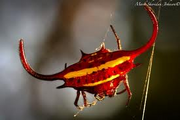
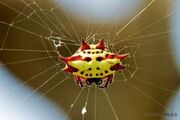
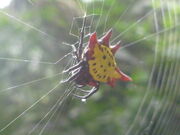
Kwazulu Natal, South Africa
